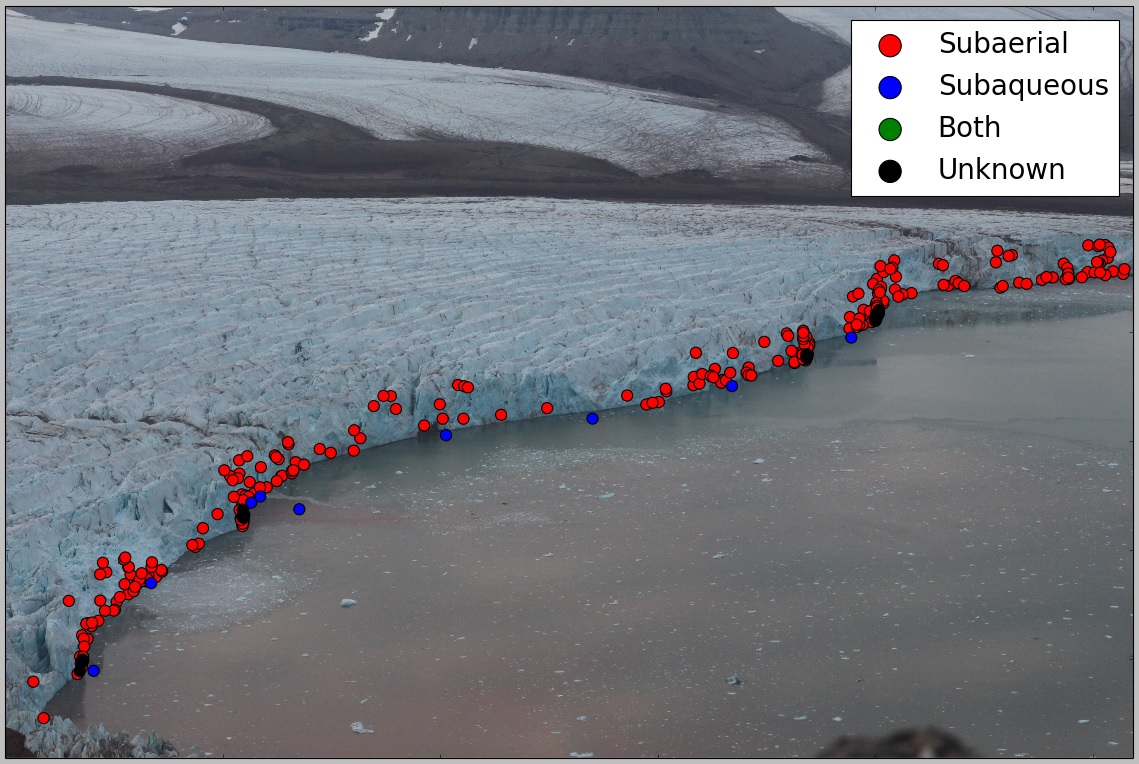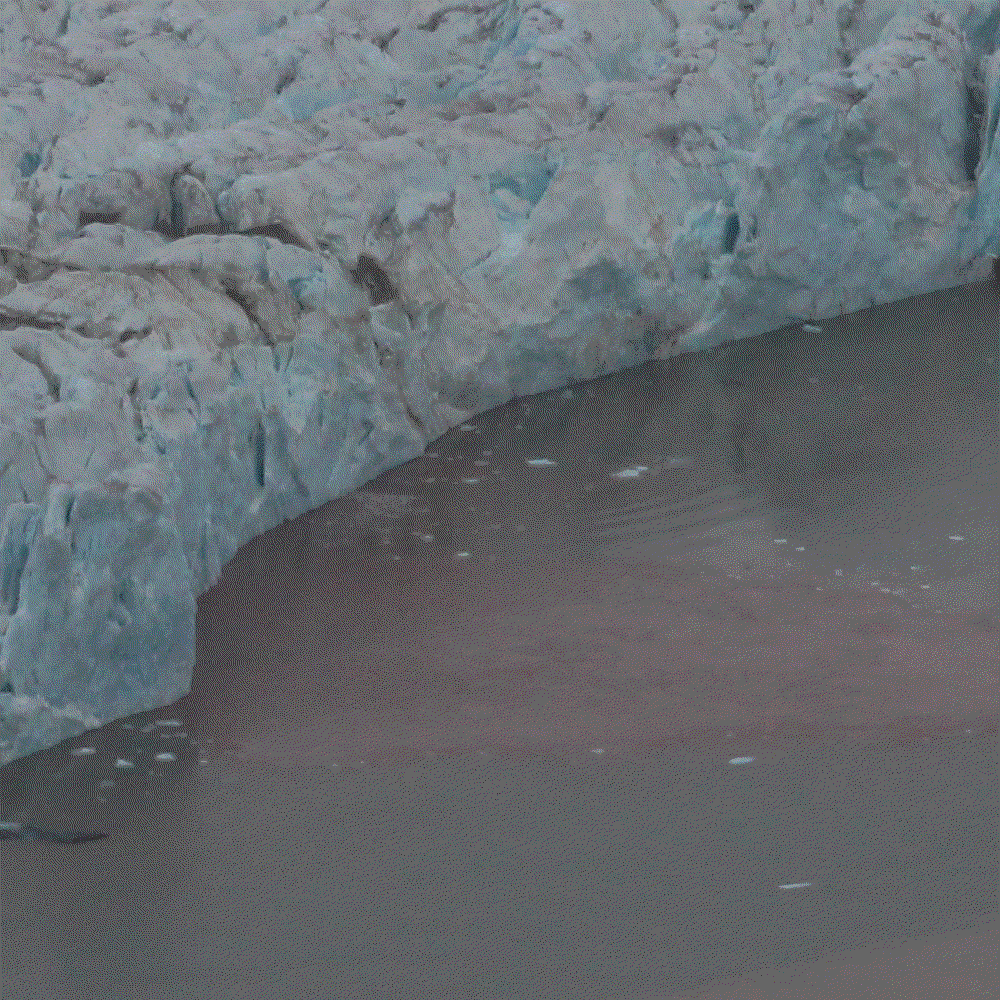PhD update: December 2015
Examining calving behaviours at two glaciers in Svalbard
Kronebreen and Tunabreen are two tidewater glaciers in Svalbard that exhibit very different calving behaviours. By calving ‘behaviour’, I mean the type of calving that occurs, and the magnitude and frequency of events. Whilst placing time lapse cameras at these two glaciers to look at longer-term calving rates, we also experimented with high-resolution time lapse photography, setting cameras to take photos every three seconds of the calving front.
We obtained a 30-hour sequence at Tunabreen and a 60-hour sequence at Kronebreen, equating to approximately 105 000 images in total (35 000 images from Tunabreen and 70 000 images from Kronebreen). From these images we could look at calving events in much more detail than previously examined.
356 calving events occurred during the 30 hours captured at Tunabreen, and 383 events occurred during the 60 hours captured at Kronebreen. Calving events can be categorised according to their origin:
- Subaerial - ice which breaks off from the area of ice face above the waterline
- Subaqueous - ice which breaks off from the area of ice face below the waterline
- Both - ice which breaks off from the area of ice both above and below the waterline, often large calving events
- Unknown - an event that is partially concealed or not able to classify due to poor visibility
These are very broad categories that effectively give an overview of calving activity. There are several finer points which demonstrate the distinct differences between calving behaviours at Tunabreen and Kronebreen specifically.

Calving events at Tunabreen over a 30-hour period in August 2015, captured using high-resolution time-lapse photography (one photo every three seconds). Calving events are categorised as subaerial (red), subaqueous (blue), both (green) and unknown (black).

Calving events at Kronebreen over a 60-hour period in September 2015, captured using high-resolution time-lapse photography (one photo every three seconds). Calving events are categorised as subaerial (red), subaqueous (blue), both (green) and unknown (black).
1. Roughly the same number of calving events occur despite the sequence from Kronebreen being twice as long as the sequence from Tunabreen. The events at Tunabreen are more frequent, but smaller than those seen at Kronebreen. Calving events at Tunabreen are often small ice crumbles which occur close to the waterline due to local undercutting. Calving events at Kronebreen are commonly larger stack or sheet collapses.
2. More subaerial calving events occur than subaqueous events. At Tunabreen and Kronebreen, subaqueous events occur every 1 in 30 times - 10 of the 356 events at Tunabreen were subaqueous; and 22 of the 383 events at Kronebreen were subaqueous. Subaqueous events often consist of large chunks of ice whilst subaerial events have a bigger range in size. Subaerial events are caused by force imbalances and turbulence at the waterline, eating back the ice face above the water and leaving the subaqueous part of the ice face. Subaqueous events occur when the buoyancy of the ice beneath exceeds the strength of the ice holding it to the front.
3. There is concentrated calving around the plumes, which has formed bays and protruding headlands across the ice front. By plumes, I am referring to upwellings of glacial meltwater in the fjord which appear as muddy streams on the surface. The turbulent mixing of freshwater with saltwater enhances the melting of the ice front adjacent to the plume. This increases the magnitude of events rather than the frequency of events, as indicated by the even spread of calving events across the fronts of Tunabreen and Kronebreen.

An example of a subaqueous calving event at Tunabreen, occurring in the plume area. The section of ice front shown is approximately 350 m, and the iceberg is 40 m wide
4. Large calving events create ripples which travel across the fjord and can cause calving events in other areas of the ice front. The ripples create turbulence at the waterline, which can break off additional pieces of ice from the front. Therefore the likelihood of a calving event is increased after a big collapse.
Broadly speaking, calving is controlled by fjord, plume and upglacier dynamics. The type of calving that occurs at a glacier comes down to how much influence each of these three components have. The difference in calving behaviour at Tunabreen and Kronebreen is largely down to the differences in upglacier velocities. Tunabreen is much slower than Kronebreen - Tunabreen flows 0.5 - 1 m per day whereas Kronebreen flows 1 - 3 m per day. Because of this, the surface of Kronebreen is heavily crevassed. This provides more weaknesses in the ice face and thus bigger failures. As Tunabreen has fewer weak points in the ice face, calving is largely confined to the waterline, where turbulence at the sea surface knocks small pieces of ice off.
By examining calving behaviours, we can begin to understand the reasons why different types of calving occurs at different glaciers. The next step with this work is to generate real numbers to further explore these ideas, such as quantify the amount of ice within each calving event and calculate the upglacier surface velocities for Tunabreen and Kronebreen. This can be achieved through photogrammetric techniques - volume estimation through georeferencing/stereoscopic analysis.
